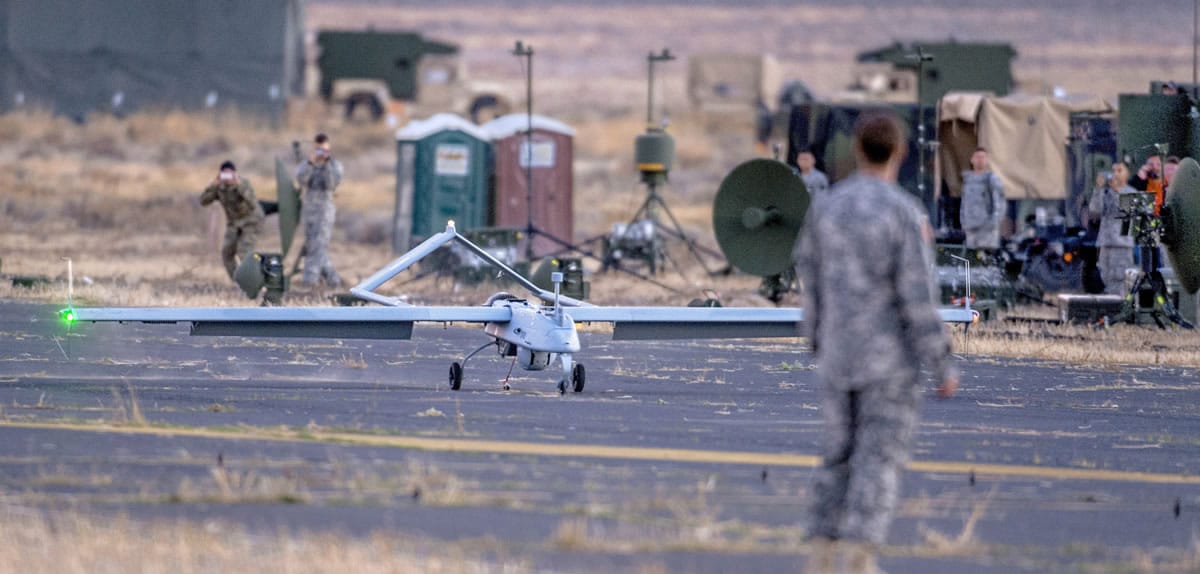YAKIMA — Daniel Fernandez used to have a fast and dangerous mission on the battlefields of Iraq and Afghanistan as an Army scout helicopter pilot.
He’d fly over a target in his Kiowa helicopter, quickly take a photo of a threat and move on before anyone could fire a shot at him.
Now the chief warrant officer is part of a Joint Base Lewis-McChord Army aviation unit that’s removing some risk from that reconnaissance assignment by leaning more on unmanned aircraft. It’s safer for soldiers, and Fernandez acknowledges the drones can gather better images than he could develop from his cockpit on combat flights.
“I would’ve loved to have half the clarity that these unmanned aerial vehicles can get,” he said. “I wouldn’t have had to get so close.”
Fernandez’s unit, the 4th Squadron, 6th Heavy Attack Reconnaissance Squadron, put the new technology to work in the field for the first time at the Yakima Training Center. The squadron is testing the latest model of an intelligence-gathering unmanned aircraft called the RQ-7B Shadow.
With the latest Shadow upgrades, pilots of powerful Apache attack helicopters someday will be able to control the unmanned aircraft while they’re in the air. That’ll give them a look at the battlefield ahead without putting themselves in danger.
“It’s a lot safer. It keeps our brothers and sisters out of harm’s way,” said Staff Sgt. Dolphise Colomb, a soldier in the reconnaissance squadron who has spent his Army career in military intelligence units.
The new assignment has its roots in a 2013 Army decision to discontinue flying its scout helicopters, the OH-58 Kiowas.
Those small helicopters served the Army since the late 1960s. They were considered expendable in the military’s post-Iraq War downsizing. As a result, JBLM lost its Kiowa squadron last year.
Fernandez’s new unit at JBLM carries the same name as its old Kiowa squadron, the 4-6. The difference is that it’s built with 24 heavily armed Apache AH-64 helicopters instead of the smaller, lighter Kiowas.
The trick for the Army is finding a way to blend the speedy qualities of the Kiowa with the firepower of the Apache.
That’s where the new unmanned aircraft enter the picture.
The squadron expects to get one RQ-7 Shadow for every two helicopters in its formation. On a typical mission, four Apache pilots in two helicopters would be joined by two unmanned aircraft operators on the ground flying one of the Shadows.
In the beginning, the drone operators will talk to the Apache pilots to give them fresh information. Later, a video feed will stream live images from a Shadow to the crew in the air.
When the teams get more advanced, the Apache pilots will learn how to take control of a camera under the belly of the Shadow. Eventually, the pilots themselves will gain the ability to direct the unmanned aircraft in flight.
The crews are moving carefully through those steps.
The exercise this week focuses on teaching ground crews how to take care of their part of the mission — launching Shadows, directing them in flight, gathering information and safely landing them. They’re getting familiar with the equipment, and with each other. Each Shadow system, including the aircraft and controls for operators on the ground, costs about $12 million.
“We are all new, so we can see how we can work with each other,” said Pfc. Anny Espinoza, 19, who is in the field at a training exercise for the first time. She joined the Army a little more than a year ago.
As a new unit with first-in-the-Army equipment, the 4-6 ran into some obstacles beginning its training in Yakima. Its first launch was delayed for several hours while crews prepped equipment.
A Shadow finally launched late in the afternoon, soaring for about an hour above Army training grounds. It landed to cheers.
Fernandez wanted to get his hands on photos of the flight taken by Army public affairs staff and visiting journalists.
“This is a historic moment for our unit,” he said.



